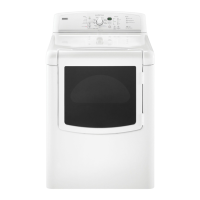What to do if Kenmore W10035270 won't start when the start button is pressed?
- WwilliamssarahAug 1, 2025
If the number display is flashing, ensure the door is completely shut. Then, press and hold the START button for about 1 second.
What to do if Kenmore W10035270 won't start when the start button is pressed?
If the number display is flashing, ensure the door is completely shut. Then, press and hold the START button for about 1 second.
Why Kenmore Dryer won't heat?
If your Kenmore dryer isn't heating, there are a few things you can check: - Heater (see TEST #4, page 8). - Harness connections. - Installation.
What to do if Kenmore W10035270 shuts off before clothes are dry?
Your Kenmore dryer might shut off too early because of the following reasons: 1. Incorrect dryness setting for auto cycles. 2. Full lint screen. 3. Clogged vent. 4. Moisture sensor (see TEST #5, page 10). 5. Dryness level adjust (see Adjusting Customer-Focused Drying Modes, page 11).
Why Kenmore W10035270 won't power up?
The appliance may not power up due to: 1. Supply connections (see TEST #1, page 6). 2. Harness connections. 3. User interface assembly (see TEST #6, page 10).
What to do if Kenmore Dryer won't shut off?
If your Kenmore dryer won't shut off when expected, you can check the following: 1. STOP button (see TEST #6, page 10). 2. User interface assembly (see TEST #6, page 10). 3. Moisture sensor (see TEST #5, page 10).
Step-by-step guide to enter the diagnostic test mode and verify entry.
Covers unsuccessful entry, saved fault codes, and specific diagnostic tests.
Procedures for checking dryer airflow and input voltage using diagnostic mode.
Steps to activate and run manual load tests for single and dual element models.
Instructions for deactivating both the diagnostic and manual load test modes.
List of fault codes, their descriptions, and recommended procedures.
Addresses issues like no power, won't start, or won't heat.
Detailed wiring schematic for single element dryer configurations.
Detailed wiring schematic for dual element dryer configurations.
Wiring schematics for drive motor and blower motor control circuits.
Wiring schematics for single and dual element heater circuits.
Diagram of moisture sensor circuit and component locations.
Procedure to check power cord and terminal block connections for proper supply.
Procedure to verify power presence at the machine control electronics.
Checks wiring and resistance of the drive motor system components.
Tests the blower motor and control electronics in dual motor models.
Procedures to diagnose issues with the dryer's heating element.
Verifies exhaust and inlet thermistor resistance values against temperature.
Procedures to test the thermal fuse and thermal cut-off for continuity.
Verifies the moisture sensor strips and harness for proper operation.
Diagnoses issues with console buttons not lighting or no beep sound.
Checks the door switch for correct activation and feedback in diagnostic mode.
Guide to modify automatic cycle drying time based on user preference.
Instructions for removing front panel, drum, and accessing electronic components.
Steps for correctly reinstalling the machine control, motor control, and user interface assemblies.
Procedure for safely removing the dryer's back access panel.
Step-by-step guide to enter the diagnostic test mode and verify entry.
Covers unsuccessful entry, saved fault codes, and specific diagnostic tests.
Procedures for checking dryer airflow and input voltage using diagnostic mode.
Steps to activate and run manual load tests for single and dual element models.
Instructions for deactivating both the diagnostic and manual load test modes.
List of fault codes, their descriptions, and recommended procedures.
Addresses issues like no power, won't start, or won't heat.
Detailed wiring schematic for single element dryer configurations.
Detailed wiring schematic for dual element dryer configurations.
Wiring schematics for drive motor and blower motor control circuits.
Wiring schematics for single and dual element heater circuits.
Diagram of moisture sensor circuit and component locations.
Procedure to check power cord and terminal block connections for proper supply.
Procedure to verify power presence at the machine control electronics.
Checks wiring and resistance of the drive motor system components.
Tests the blower motor and control electronics in dual motor models.
Procedures to diagnose issues with the dryer's heating element.
Verifies exhaust and inlet thermistor resistance values against temperature.
Procedures to test the thermal fuse and thermal cut-off for continuity.
Verifies the moisture sensor strips and harness for proper operation.
Diagnoses issues with console buttons not lighting or no beep sound.
Checks the door switch for correct activation and feedback in diagnostic mode.
Guide to modify automatic cycle drying time based on user preference.
Instructions for removing front panel, drum, and accessing electronic components.
Steps for correctly reinstalling the machine control, motor control, and user interface assemblies.
Procedure for safely removing the dryer's back access panel.












